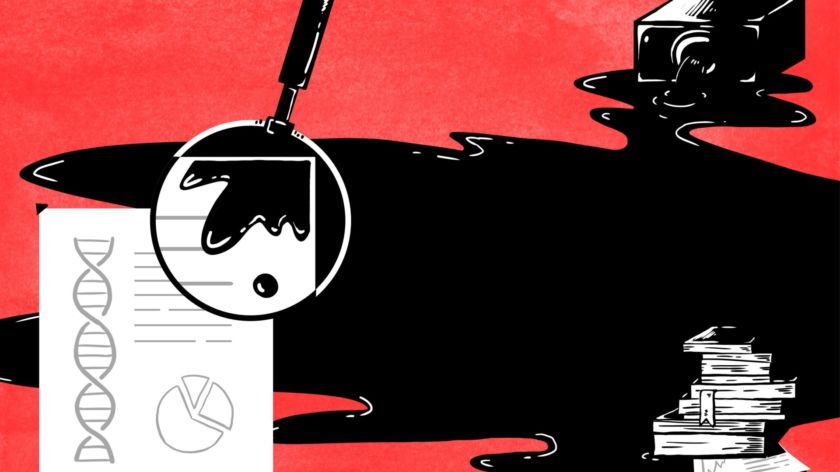Universities are also to blame for researchers’ misconduct
-
 The cover illustration of Horbach’s PhD thesis. Illustration: Marlies Nillesen
The cover illustration of Horbach’s PhD thesis. Illustration: Marlies Nillesen
Whereas economists do copy themselves at times, it will be rare to catch a historian self-plagiarising. And there are a lot more cultural differences in the area of academic integrity within the universities. Serge Horbach will receive his PhD for his thesis on this topic. ‘A one-size-fits-all approach will not work.’
You do not need to tell Serge Horbach that academic integrity is a sensitive topic. During the past four years that the PhD candidate worked on his thesis, he dropped two bombshells on the subject of academic mores.
The first one was in September 2017, when Horbach and his supervisor Willem Halffman established that researchers commit self-plagiarism on a large scale. Especially economists like to copy themselves: one in seven publications in their field contains a problematic amount of recycled text. Horbach and Halffman also showed that researchers who publish a lot, often reuse existing sections of text.
The second bombshell followed only a month later. This time Horbach wrote, again with his supervisor, that in at least 30,000 publications the results are based on research with misidentified cells (see frame).
Misidentified cells
Together with Willem Halffman, Serge Horbach examined a database with publications dating back to 1955. According to their conservative estimate, 33,000 scientific studies were published in which a misidentified cell line was used. The problem is that many cell lines are contaminated by other biological cells. ‘Cultivating cells can be very difficult sometimes,’ Horbach told Vox previously. ‘A single drop of airborne water that mixes with the cells may be enough for the cell line to be contaminated.’ The strange thing is that although the problem has been known for years, little has been done to remedy the situation.
Horbach: ‘You can count on it: every time we publish something about academic integrity, my e-mail inbox fills up. Researchers write about what they experienced and which barriers they encounter when trying to report it.’ Referring to his 350-page thesis: ‘I could fill another book like it using that correspondence.’
You specifically focused on these two forms of integrity issues: using misidentified cells and self-plagiarism. Why?
‘Everyone agrees that you’re not allowed to mess with data or invent data. But the last few years there has been increased attention for behaviour that deserves equal scrutiny: should you really do that? We call it questionable research practices. They are the grey areas. Self-plagiarism and using misidentified cells are examples of that.’

‘We started our research into self-plagiarism as a result of the affair concerning economist Peter Nijkamp (whose publications were reviewed by the academic integrity committee of the VU Amsterdam, red.) He appeared particularly productive, and published three papers per week. Ultimately it appeared that some of his articles hardly contained any new information at all.’
Is it a problem that researchers copy themselves?
‘It depends on the context. You do not need to change the description of an experiment every time, as long as you are transparent about it in the references. But using the same results over and over for different publications is less useful I think.’
What is the reason researchers reuse their own texts?
‘They are under great time pressure, and they are judged on the number of publications. And it is not only malicious researchers who are guilty of this. It also involved people who operate in a system with motivations and pressure that push into a particular direction, perverse incentives.’
In your thesis you write about cultural differences within science. Can you provide an example?
‘Within Economics it is reasonably normal to reuse your own texts. But this is not done within History. What I want to highlight with my research is that those differences exist, and that a different approach is needed for each field.’
‘Many of the scandals in science took place within Psychology and the Biomedical Sciences. The danger is that we are going to translate ideas about integrity that exist there to all disciplines. A one-size-fits-all approach will not work. One set with rules for all disciplines is not a good idea. In some fields it is a good idea to establish research protocols and publish them in advance, but I would not know what that would look like for fundamental mathematics or philosophical research.’
‘It is more difficult for researchers with a temporary contract to address issues’
You said that researchers have to manage systemic factors such as pressure to publish. Who should be responsible for preventing academic misconduct?
‘Everyone has to deal with the same system. And yet some researchers can resist temptation, and others cannot. Every individual has a responsibility, but there is a very strong emphasis on that individual responsibility at the moment. You often see that researchers are personally attacked while it may be more important to have a closer look at the organisations for which they work.’
What can a university do?
‘There are good discussions about the way in which researchers should be assessed. Should we evaluate each other by counting publications? Additionally, the Radboud University Executive Board emphasises the creation of a culture in which each person’s work can be talked about and discussed openly. This will increase the reciprocal checks on each other. I think that is a good thing.’
Do you think that culture is not sufficiently in place?
‘It is more difficult for young researchers with a temporary contract to address issues. They are afraid that they will not be taken seriously or that they will have to deal with repercussions from above. I base that information on an employee survey of seven European universities, including Radboud University. And I add to that all the personal stories that I hear from the researchers themselves, but that is anecdotal evidence.’
Besides the universities you also write about the role of academic publishers. They could play an important role in preventing academic misconduct. In what way?
‘When there’s another scandal, many people say: ‘How did this ever pass through the peer review system? We should have caught it.’ And this is true in a certain sense. But you cannot expect everything from peer reviewers. It is all voluntary.’
‘As a young researcher you start with full confidence in science. I have grown a bit more cynical’
‘Publishers can play a larger role. They want the best for science – they also want good science in their journals – but other interests are just as important to them. Commercial arguments to change or not are at the forefront – they are mainly interested in streamlining processes or gaining a better reputation for example.’
What innovations are they blocking?
‘Take the registered reports. That is a system that is only implemented gradually. The idea is that researchers write an introduction before they start their research, and they include the question they aim to answer and the method they are going to use. Based on that, the journal will decide whether it is interesting enough to publish. That way, the results do not dictate whether something is published. That system takes more time, but may be a solution for the fact that mainly spectacular finds are published at the moment. While it can be just as worthwhile to publish about a causal relationship that is not demonstrated. In addition, this method means that researchers will not adjust their hypothesis afterwards and then claim: ‘look, that’s exactly what we expected.’
You focused on academic integrity for four years. What has this done to your trust in science?
(laughs) ‘It goes up and down in waves. As a young researcher, of course you start with full confidence in science. And many people have this confidence, fortunately. But as I progressed in my research, I have become more cynical. And when you read in the paper about something that is alleged to be scientifically proven, then I do think: sure…’
‘But taking stock, I still believe in science. Most research produces good, relevant knowledge. But we have to remain critical of ourselves.’
Your findings about misidentified cell lines and self-plagiarising researchers does not do much to improve trust in science.
‘That is true. It is something that goes around in my head and I am aware of it. When I talk to journalists I look for a balance: I want to show that things go wrong, but I am not there to make all of science look bad. I do not want to feed all sorts of post-truth and alternative facts sentiments.’
How do you do this in practice?
‘By also paying attention to hopeful developments: good discussions are had about the assessment model for researchers. And I put things in perspective. 30,000 publications that are based on research with misidentified cells sounds like a large number, but it is maybe only one percent of all the biomedical research that has been done.’



